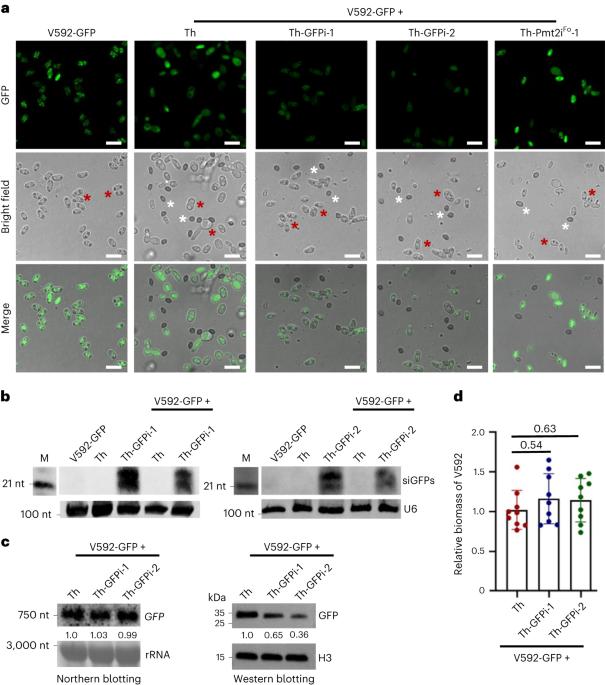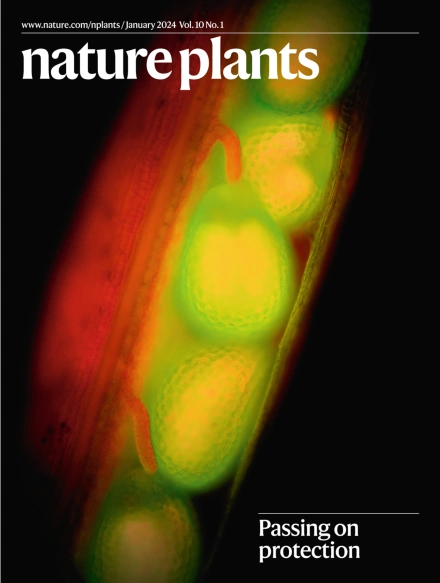Microbe-induced gene silencing boosts crop protection against soil-borne fungal pathogens
IF 13.6
1区 生物学
Q1 PLANT SCIENCES
引用次数: 0
Abstract
Small RNA (sRNA)-mediated trans-kingdom RNA interference (RNAi) between host and pathogen has been demonstrated and utilized. However, interspecies RNAi in rhizospheric microorganisms remains elusive. In this study, we developed a microbe-induced gene silencing (MIGS) technology by using a rhizospheric beneficial fungus, Trichoderma harzianum, to exploit an RNAi engineering microbe and two soil-borne pathogenic fungi, Verticillium dahliae and Fusarium oxysporum, as RNAi recipients. We first detected the feasibility of MIGS in inducing GFP silencing in V. dahliae. Then by targeting a fungal essential gene, we further demonstrated the effectiveness of MIGS in inhibiting fungal growth and protecting dicotyledon cotton and monocotyledon rice plants against V. dahliae and F. oxysporum. We also showed steerable MIGS specificity based on a selected target sequence. Our data verify interspecies RNAi in rhizospheric fungi and the potential application of MIGS in crop protection. In addition, the in situ propagation of a rhizospheric beneficial microbe would be optimal in ensuring the stability and sustainability of sRNAs, avoiding the use of nanomaterials to carry chemically synthetic sRNAs. Our finding reveals that exploiting MIGS-based biofungicides would offer straightforward design and implementation, without the need of host genetic modification, in crop protection against phytopathogens. This study develops a microbe-induced gene silencing technology by constructing an RNAi engineering microbe to prove the existence of interspecies RNAi in rhizospheric fungi and demonstrate its application in crop protection against fungal pathogens.

微生物诱导的基因沉默增强了作物对土传真菌病原体的保护作用。
小核糖核酸(sRNA)介导的宿主和病原体之间的跨王国核糖核酸干扰(RNAi)已得到证实和利用。然而,根际微生物中的种间RNAi仍然难以捉摸。在本研究中,我们利用根际有益真菌哈茨木霉开发了一种微生物诱导基因沉默(MIGS)技术,利用一种RNAi工程微生物和两种土传病原真菌大丽黄萎菌和尖孢镰刀菌作为RNAi受体。我们首先检测到MIGS在大丽花中诱导GFP沉默的可行性。然后,通过靶向真菌必需基因,我们进一步证明了MIGS在抑制真菌生长和保护双子叶棉花和单子叶水稻免受大丽花和尖孢镰刀菌侵害方面的有效性。我们还显示了基于选定靶序列的可操纵的MIGS特异性。我们的数据验证了根际真菌中的种间RNAi以及MIGS在作物保护中的潜在应用。此外,根际有益微生物的原位繁殖对于确保sRNA的稳定性和可持续性是最佳的,避免使用纳米材料携带化学合成的sRNA。我们的发现表明,利用基于多边投资担保机构的生物杀真菌剂可以在不需要宿主基因修饰的情况下,为作物抵御植物病原体提供直接的设计和实施。
本文章由计算机程序翻译,如有差异,请以英文原文为准。
求助全文
约1分钟内获得全文
求助全文
来源期刊

Nature Plants
PLANT SCIENCES-
CiteScore
25.30
自引率
2.20%
发文量
196
期刊介绍:
Nature Plants is an online-only, monthly journal publishing the best research on plants — from their evolution, development, metabolism and environmental interactions to their societal significance.
 求助内容:
求助内容: 应助结果提醒方式:
应助结果提醒方式:


